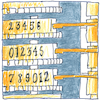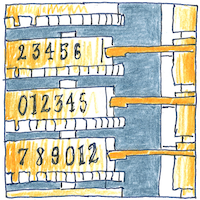Charles Babbage
computer science

|
Difference engine
Patterns for weaving were traditionally drawn on squared paper. Basile Bouchon invented a mechanism in which the cords of the warp for setting up a drawloom are threaded through the eyes of needles that are raised or lowered by the mechanism according to whether a hole for each needle appears in a perforated paper tape. Bouchon’s assistant, Jean-Baptiste Falcon, arranged the holes in rows on rectangular cards joined together in a loop. This mechanism eliminated errors in interpretation and setting up the pattern but required a second operator to control it. Jaques Vaucanson was the first to try to fully automate the loom using Bouchon’s mechanism and Falcon’s cards but weavers didn’t like the idea and pelted him with stones on the street. Fifty-six years later, Joseph Marie Jacquard succeeded automating the loom with punch cards using a similar mechanism with hooks attached through the harness to multiple threads to allow repeats across the weft. The Jacquard loom used punched cards to control a sequence of operations. so that changing the cards changed the pattern. It was not a great leap for Charles Babbage to store programs on punch cards that controlled the operations of his Difference Engine.
Non-fiction
Babbage’s engine could be featured in a Hollywood film of a novel by Jules Verne—a computer running on steam power, all oak and brass hissing and clanging huge as a locomotive, and working either for good or for evil. But it itself never threatened or saved the world only the idea—ahead of its time and the mechanics that could have made it economically feasible.
Weaving
Ada Augusta King, Countess of Lovelace, died at the age of thirty-six but wrote for Babbage’s Analytic Engine (which was never built but was the true precursor to the modern general-purpose computer) the first computer program and she wrote that the engine “weaves algebraic patterns.”



Even though some of the mechanics had been invented before him, and even though his ideas would not become practical for a hundred years, Babbage’s engine was revolutionary.
The Difference Engine was designed to approximate the solutions of polynomial functions using Newton’s method of divided differences for the construction of astronomical and mathematical tables. This machine was cranked by hand.
The Analytical Engine, in contrast, was designed as a general-purpose Turing-complete machine.
Ada Lovelace wrote her program to calculate the sequence of Bernoulli numbers as an illustration for her translation of Luigi Menabrea’s memoir on the Analytical Engine.
See also in The book of science:
Readings in wikipedia: